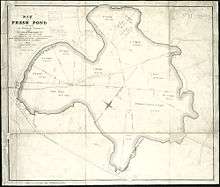Fresh Pond (Cambridge, Massachusetts)
| Fresh Pond | |
|---|---|
 The pond in winter | |
 General plan for Fresh Pond Park, by the Olmsted Brothers landscape design firm (1897). "[A]lmost none of the plans to relocate the carriage drive [to the route shown] were ever implemented."[1] | |
| Location | Cambridge, Massachusetts |
| Coordinates | 42°23′N 71°9′W / 42.383°N 71.150°WCoordinates: 42°23′N 71°9′W / 42.383°N 71.150°W |
| Type | reservoir |
| Basin countries | United States |
| Surface area | 155 acres (63 ha) |
Fresh Pond is a reservoir and park in Cambridge, Massachusetts. Prior to the Pond's use exclusively as a reservoir, its ice had been harvested by Boston's "Ice King", Frederic Tudor, and others, for shipment to North American cities and to tropical areas around the world.[2]
Fresh Pond Reservation consists of a 155-acre (627,000 m²) kettle hole lake, and 162 acres (656,000 m²) of surrounding land, with a 2.25 mile (3.6 km) perimeter road popular with walkers, runners and cyclists, and a nine-hole golf course.[3]
Early history
Native Americans used the pond for fishing and drinking water for several thousand years. Starting in the seventeenth century colonists fished for alewives using fishing weirs in Alewife Brook (which passed through the swamps to the north of Fresh Pond) following the Native Americans' methods. The colonists also used the fields around Fresh Pond for growing hay, and they hunted ducks in the Pond. In the eighteenth century, settlers started farms to the south, west and north of the Pond. In 1796 Jacob Wyeth constructed the Fresh Pond Hotel to the east of the Pond on land that is now part of Kingsley Park. In 1798 a wealthy resident constructed a country estate north of the pond on Black's Nook. In the early 1800s clay was removed from the swamps surrounding Fresh Pond for use in the brick making industry.
Water and ice
In the mid-19th century, the Pond was privately owned and home to a flourishing ice-harvesting industry, with ice shipped as far as Europe, China, and India.[2] Entrepreneurs began cutting ice from Fresh Pond in the 1820s.[4] The horse-drawn Charlestown Branch Railroad expanded to connect the Fresh Pond icehouses of Frederic Tudor, Addison Gage, and Nathaniel J. Wyeth with several wharves in Charlestown.[5] The first ice shipment was in December 1841.[6] The railroad would later get steam locomotives and become part of the Fitchburg Railroad.
In 1856, a private company began supplying its customers with drinking water from the Pond. In 1865 the business came under city ownership. By the end of the century the Pond and the land surrounding it was entirely city-owned, and an elaborate public water supply system had been developed.

Fresh Pond is part of the overall Cambridge water system. Its water is fed to the pond via an aqueduct from the Hobbs Brook and Stony Brook Reservoirs, located in Lexington, Lincoln, Waltham and Weston, Massachusetts.[7] After purification at the Walter J. Sullivan Water Treatment Facility adjacent to Fresh Pond, the water is pumped upwards to the underground Payson Park Reservoir in Belmont. From there it flows back to Cambridge, with gravity providing the pressure to distribute drinking water to residents and businesses.[8]
Transportation
Fresh Pond is bordered by Fresh Pond Parkway, Huron Avenue, Grove Street, Blanchard Road, and Concord Avenue. The Reservation can be reached via the Minuteman Bikeway or MBTA 72, 74, 75, and 78 buses. It is about a ten-minute walk from Alewife Station on the MBTA Red line.
Proposed Watertown-Cambridge Greenway
A portion of the abandoned Watertown Branch Railroad is situated between Fresh Pond Parkway and the water treatment facility. Currently overgrown in parts, this single track line enters the Fresh Pond reservation at its northeastern edge, near the Concord Avenue–Fresh Pond Parkway rotary. The line continues in a southerly direction along much of the eastern boundary of the reservation until it reaches the Huron Avenue overpass to the south. The branch terminates in the nearby town of Watertown. There are plans to have this rail line, disused since 2001, converted into a rail trail and linear park. A section in Watertown, from Grove Street to School Street, opened in 2011. Construction of the remaining section is scheduled to begin in 2018.
See also
Footnotes
- ↑ Sinclair, Jill (April 2009). Fresh Pond: The History of a Cambridge Landscape. MIT Press. p. 94. ISBN 978-0-262-19591-1.
- 1 2 Weightman, Gavin, The Frozen-Water Trade: A True Story, New York, Hyperion, 2003.
- ↑ Fresh Pond Golf Course Accessed 2008-10-02
- ↑ IV the Ecological and Social History of Fresh Pond Reservation http://www2.cambridgema.gov/CityOfCambridge_Content/documents/4.%20Ecological%20and%20Social%20History.pdf
- ↑ BIKE TOURS OF CAMBRIDGE 2008
- ↑ A Brief Chronology of Fresh Pond
- ↑ Map of Cambridge drinking water source area Accessed 2008-10-02
- ↑ Cambridge Water Department: Where Does Our Drinking Water Come From? Accessed 2017-07-09
General references
- City of Cambridge Water Department
- Fresh Pond history
- Sinclair, Jill (April 2009). Fresh Pond: The History of a Cambridge Landscape. Cambridge, Massachusetts: MIT Press. ISBN 978-0-262-19591-1.
- Weightman, Gavin (2003). The Frozen-Water Trade: A True Story. New York: Hyperion
- Seaburg, Carl and Alan (2003). The Ice King: Frederic Tudor and His Circle. Boston: Massachusetts Historical Society
External links
| Wikimedia Commons has media related to Fresh Pond. |
- "About Fresh Pond Reservation". Friends of Fresh Pond Reservation. Retrieved 7 August 2011.